Question to Ponder: If Betty Boop (or Helen Kane) inspired Marilyn Monroe's look, did Jessica Rabbit inspire Pamela Anderson's look!?!?!?
Everything is meaningless...
Thursday, November 23, 2006
Wednesday, November 22, 2006
So I kind of had the idea to take random quotes from the surveys I took and turn them into images on posters. This is just kind of a sketch of what it might look like. I put Betty Boop's head on an anorexic girl's body, because I got a quote from Adrienne that said: "Yes, she's still sexy, but in a different way than today's sexy. She is voluptuous, rather than stick thin like today's "beautiful" women."
So here is what my idea looks like, so far. It will be executed differently, though:

Tuesday, November 21, 2006
Well, today I pretty much spent the entire day gathering information about Betty Boop in every way possible...or at least every way that I have thought of so far. I have done surveys (at least 20 now...and many more to come!) and I have watched several vintage cartoon animations on YouTube (which is so fabulous, I love it!) and I have visited fan sites and informational sites alike. I have also done some studying of Mae West and Helen Kane...two of the women who inspired Betty's look. I have also downloaded and listened to many of Helen Kane's songs, which I like very much (and I am finding out that this project has many perks- because now I know of a style of music that I like, and have never heard of before!). So, now that I am all booped out, I am going to bed....but tomorrow I plan to study more about Helen Kane, and her lawsuit against the creator's of Betty Boop. I also want to learn more about how the cencorship laws screwed up Betty's sexual image.
Doing all this research has kind of changed my idea and given me some inspiration. I wanted originally to do a documentry on film, but now (since I couldn't get a camera from school) I have done surveys over the internet, and found a new direction. I am thinking of trying to alter Betty's image to fit today's standard of sexuality/beauty. Most people said she wasn't as sexy as Jessica Rabbit or Aeon Flux. Most people also had a derogatory comment about her overly large head. I might want to do some more research on how I can make my own new version of Betty Boop that might be more visually pleasing according to today's standards. Hmmm something to think about. I also breifly sketched a Betty Boop head on an anorexic girl's body- just to be a little provocative. Seems like what people think is beautiful today is stick thin, sized 0 girls with their ribs showing....well not good ol' Betty. Betty was a normal sized girl with an hourglass figure. She looked hot. Haha. Anyway, I want to see what people's reactions would be if I put that up.
I posted surveys on myspace and facebook.
Here is a link to the facebook group- if you are on facebook, please join! If you want to fill out the survey, please leave a comment. No cheating!
http://fitnyc.facebook.com/group.php?gid=2221002169
Here is the survey:
1- Who is Betty Boop?
2- When did she come into the picture?
3- What does she represent?
4- What is her "catch phrase"?
5- How does she relate to modern society?
6- How was she portrayed in films- the heroine, the helpless victim?
7- Why is her head so friggen huge, and her feautres so over emphasized?
8- Why has her image endured so long and been so popular?
9- Who is the sexiest female cartoon character?
10- Is Betty Boop's look still sexy?
Here is the first response I got, from my friend John Culkin, 21 yrs old, from NY:
1..She was a popular cartoon character during the early 1900's.
2. Have no idea. I think the 1920's.
3. The perspective people had of women during those times.
4. Boop-boop-bee-doop
5. Not sure
6. The helpless victim
7. Don't know
8. Don't know
9. Jessica Rabbit
10. No
Whose the Sexiest of them All?
Someone in my group mentioned that I might want to do research on the "evolution of the female cartoon character." Betty was the first female cartoon character to be overtly sexual, but certainly not the last. Later on came Olive Oyl, Jessica Rabbit, Princess Jasmine, and others. I found a funny website that is a forum of people discussing who the sexiest of them all is! Of course Betty was mentioned... :)
http://forum.bcdb.com/forum/_C1/_F3/Sexiest_Female_Cartoon_Character_P3947/
Betty Boop's Rise to Fame, 1934
Doesn't it seem like Betty always gets herself in trouble? That was the cutest interview ever!! I love how the cartoon Betty interacts with the real life people.
A newspaper man interviews Fleischer who animates Betty and then goes into a retrospective of past episodes.
THE ELUSIVE BETTY BOOP: Where did she come from?
It is unlikely that many of the teenage girls who carry Betty Boop keychains or wear Betty Boop T-shirts have ever seen any of the original Max Fleischer cartoons starring Betty. To most Americans under the age of 35 or so, she is probably just an icon, with no more sense of history than Tony the Tiger, Lucky Leprechaun, Count Chocula, or any of the other cartoons that serve as advertisements for cereal.
Her figure was modeled after Mae West's and her singing style taken from Helen Kane the "Boop-Boop-a-Doop" girl. The voice of Betty was that of May Questal.
Some think Betty Boop was modeled after Mae West:


Others think she was modeled after Helen Kane...especially her singing style. Here is a clip of the theme song of Betty Boop:
http://www.angelfire.com/retro2/vintager06/Music/HelenKaneBettyBoopThemeSong.wav
This website: http://www.angelfire.com/retro2/vintager06/HelenKane.htm has many Helen Kane songs.
Here is a cute one:
http://www.angelfire.com/retro2/vintager06/Music/HelenKaneIOweYou.wav
Here are photos of Helen Kane:






Helen Kane inspired not only Betty Boop, but also Marilyn Monroe!!
"In digging more info on Jobyna, Dennis Lambert acquired a book on Hollywood stars from 1930. In this book was not only a picture of Jobyna but also of Helen Kane, "The Boop-a-Doop Girl", who inspired both Betty Boop and Marilyn Monroe and who physically looks very much like the leading lady of Humor Risk. She was born in the Bronx as Helen Schroeder (or Schroader) and appeared in numerous stage plays in New York before being discovered for films. The book gives her birth date as 4 August 1908, which would make her quite young to have appeared in Humor Risk, but other sources says she was born in 1903 and if so, the chronology would fit. Helen went with the Marxes to Britain (On The Balcony) in 1922, so there's a definite connection between them. But why then did Groucho mention "Harold Lloyd's leading lady" and not the "Boop-a-Doop Girl" in connection with Humor Risk? Another misremembrance in his old age?"
From a Betty Boop Fan Site:
Betty Boop started out in the early 1930's as a dog character, primarily as the love interest of a dog character named Bimbo, in the Talkartoons series produced by Dave & Max Fleischer. She was featured in several cartoons as this dog character through 1930. It didn't take long for Betty to surpass Bimbo in popularity, and become the main character in the cartoons. (From: Starring Bimbo, featuring Betty, To: Starring Betty, featuring Bimbo.) In many of her cartoons Bimbo was portrayed either as her boyfriend, or at least a wanna-be boyfriend. As Betty's popularity grew, she went through a transformation, losing her dog characteristics. (Although her dog ears hung on for a little while, before becoming earrings) Before long she became the cute and sexy character that we Betty Boop fans have grown to love. Her body was modeled after Mae West, and her voice was done by Mae Questal. There were more then one hundred Betty Boop cartoons produced, including, "Betty Boop for President" (1932), "Bamboo Isle" (1932), and "Riding the Rails" (1938), which even received an Oscar nomination. Trick or Treat One of my favorite characters in her cartoons is Grampy, the eccentric inventor who, after putting on his thinking cap, seems to be able to solve any problem. Grampy's way of doing things, was always fun, and to say the least, unique. Another character that showed up occasionally was Koko the clown, although he usually appeared as nothing more then an "extra" in Betty's cartoons. And then there's Pudgy, Betty's little dog . He's featured in many of her cartoons, in fact there seem to be a couple of cartoons that he is the primary character. Some of my favorite Betty Boop cartoons include: "Poor Cinderella" (1934), "A Language all my Own" (1935), and "Betty Boop and the Little King" (1936). Betty's popularity began to decline after her creators were forced to "clean her up" under the Hays Code. Gone were the short little skirts with her garter showing. Her hemline moved down to her knees, and her character took on more of a school teacher persona. Since it was the "cute" and "sexy" characteristics that made Betty popular, eliminating them meant the beginning of the end of Betty's popularity. During her prime, it was not uncommon to see big name musical guests making appearances in her cartoons. Some of these were: "I'll be glad when you're Dead, You Rascal You" (1932), featuring Louis Armstrong, "Minnie the Moocher" (1932), featuring Cab Calloway, and one of my favorites "Snow White" (1933) featuring Cab Calloway doing the song A skiing we will go... "Saint James Infirmary Blues". In the 1930's, Betty Boop was made into dolls, toys, and other collectibles. Her popularity declined for several decades, but then, in the 1980's she began to become popular again. Now, as she becomes more popular, there are many products and collectables available. Some of the items I have are dolls, ceramics, T-shirts, posters, watches,and more. Almost anything you can think of, is now available. I think that Betty is as popular now, as she has ever been.


by Gary Morris
Recent right-wing attacks on the Internet as not being "safe for children" remind us that there were times in our cultural history when "safe for children" was not at the top of an artist's agenda. (Maybe when parents, not artists, were expected to police kids.) During the pre-Code era of the early 1930s, Hollywood cranked out an endless supply of movies featuring slick pimps, murderous prostitutes, screaming queens, unrepentant gangsters, and other such characters who make life worth living.
Even kiddie art forms like cartoons weren't "safe." This can be attributed largely to the violent, sexy, jazzy, and imaginative work of Max and Dave Fleischer, arch-enemies of the Disney aesthetic and creators of the big-screen Popeye and Betty Boop. Betty Boop Confidential lets us rediscover some of Betty's best work for the Fleischers, along with a few other Depression-era surprises.
Betty is best remembered for her red-hot jazz baby persona. With a head like a giant peanut, vast mascara'd eyes, too-kissable lips, baby-doll voice (courtesy of singer Mae Questel), flattened marcelled hair, and mere threads of a dress exposing miles of hot flesh, she was the perfect celluloid sex toy.
It wasn't just her flesh, though there was plenty of that; Betty practiced what her body preached. We see her frequently undressing and stealing kisses from clowns and cats and other indeterminate creatures, as well as a more humanish Prince Charming. Not that Betty didn't have her standards. When the fat circusmaster in Boop-Boop-a-Doop (1931) runs his hand up and down her exposed thighs, Betty recoils in disgust and sings a mock-lament to the sympathetic circus audience: "Please don't take my boop-boop-a-doop away." Now, what could she have meant by that? In Poor Cinderella (1934), dressed in her familiar teensy black bra and shredded skirt, she again bemoans the lack of sex — I mean, romance — in her life as she sings, "Always in the way... I can never play."

Poor Cinderella
In Bimbo's Initiation (1931) she cooperates with a group of creatures of uncertain ethnicity and species in trying to persuade/force Bimbo (her pal in some of the cartoons) to join their "Mystic Order of the Boom Boom a Latcha!" They try all kinds of violent and mystifying tricks, but only Betty succeeds through sheer attitude by sticking out her suddenly elongated buttocks and coyly whacking them before a jacked-up, mesmerized Bimbo.
Sadomasochists will enjoy Boop-Boop-a-Doop for its image of Betty as dominatrix, eagerly cracking the whip at a group of menacing lions. One of these lions gives jaded modern audiences a bonus, as he turns out to be a mincing queen who's the soul of dainty decorum: "Pahdon me," he says to Betty, "you dropped ya handkachief."
Another thing that set Betty apart from the "cute li'l animals" schools of cartooning that abounded in this pre-Warner Bros. era was her association with black jazz. In a Snow White (1932) that capsizes the Disney feature six years later, Betty's friend Koko the Clown lip- and hip-synchs Cab Calloway's "St. James Infirmary Blues," right down to the strutting and pimping. Snow White is also a textbook example of what made the Fleischers great, as Koko is magically transformed not only into Cab Calloway, but also a ghost, a gold coin, and a liquor bottle that drinks itself. Like the Fleischer cartoons themselves, Betty's "simplicity" masks a world of jazz-age sophistication.
This retro is as much about the Fleischers as about beloved Betty and features several non-Betty cartoons. Swing You Sinners! (1930) is a typical example of their handiwork, as Bimbo is terrorized by every piece of a graveyard right down to the grass after trying to steal a chicken. You Try Somebody Else (1932), a "bouncing ball" singalong with a young, brassy Ethel Merman, features one of the Fleischers' most bizarre (but typical!) images: a group of smiling animal convicts strapped to electric chairs in a careening traincar, laughing while they get fried!
Betty Boop on Ebay:




Here is a vintage Betty Boop Helen Kane postcard (going for about 11 bucks...)
Why do people still love to buy and sell Betty Boop things today when the original meaning and image of Betty has changed so much?! Look at how many different looks she has had... she started off looking like a dog. She has been the sexy Betty in the little black dress, the slinky long red dress with a slit, the "biker Betty," "waitress Betty," "pouty Betty," etc. People sell mugs, clocks, watches, lunch boxes, bags, tins, dolls, figurines, lighter sets, cell phones, watches, jewelry, and anything you can imagine with her image on it! It's amazing.
THE EVOLUTION OF BETTY BOOP!!
After watching many Betty Boop cartoons on YouTube (thank God for technology!!) I have found that the original Betty Boop from the 1931 Betty and Bimbo cartoons looked much different! She looked more like this:



This is an early Fleischer cartoon from 1930 starring Bimbo and featuring the character who would soon become Betty Boop.
You should see some of the comments that people posted on this cartoon on YouTube!!
Thejeep2000
Thanks for this.......didn't know Betty Boop did this song before Popeye and Bluto.........great surreal stuff......the doors...sofa and Bimbo diving into it...the cat gossips.....and they were only playing draughts :) reminds me of Roger Rabbit with them playing pattercake pattercake...
You tube is the best to see early cartoons....now if the computer turned into a telly.I can see this happen with You tube.......anyway thanks again laughland
Sha4me
i always thougt that betty boop had a relation with popey but i think i forgot cauz i was very young
twistedstiletto
Barnacle Bill! ^_^ One of my favorite Betty Boop classics! I have this one on DVD...also, a lot of classics where Betty was a dog =) Thanks for putting this one up!
LoveTHYconan
insanity. :D
Tsubahi
Delightfully cheesy!
lastangelman
I hadn't seen Barnacle Bill for over twenty five years, not a bad copy, thanks for posting this classic on YouTube!
dukeyflyswatter
Man she's got a rack on her. Eat yer pie?! Beezar. Thanx
chiro9
boop boop a doop betty looks better as a dog
virgokitty
Gotta love me some betty.
Anybody old enough to have smoked hash back in the late twenties or thirties? Must have been some potent stuff.
MKFaizi
That spread leg dance at the window is quite astonishing and the way she rolled in the sofa. I am amazed that my parents let me watch this sort of thing. They did not let me watch Alfred Hitchcock Presents but I used to sneak out into the hallway and listen to it anyway.
smurfswacker
Isn't that Betty singing backup at the end when they do a little of "Minnie the Mermaid"?
I can't figure out why Fleischer cartoon characters just muttered random bits of dialogue instead of speaking normally. And the villains always just said "RRrrrarrrgrr" no matter what they were doing at the time.
Larynxa (1 week ago)
The muttering was because Mae Questel (who voiced Betty Boop & Olive Oyl) and Jack Mercer (who voiced Bimbo, Grampy, Wimpy, Popeye, etc.) improvised a lot during the recording sessions. There's no way the animators could synch the lip movements to everything that was said, so the mutterings were a short cut to cover this up.
hamfat54 (1 week ago)
The actors in Fleischer cartoons were improising the dialogue live to a screen (along with the musicians in the studio). Because they often thought of funny things to say when the characters weren't moving their lips they would mutter asides under their breath.
I think its kind of interesting getting people's reactions to her cartoons. Some think she is HOT while others clearly dont ('she looked better as a dog'). I kind of think she was cute, and then became hotter with time. That also might have to do with my perception of hot, from what I have grown up with in the media, etc. I want to get people's reactions on the different styles of drawings of Betty Boop. How did she go from a French poodle to a sexy girl??:


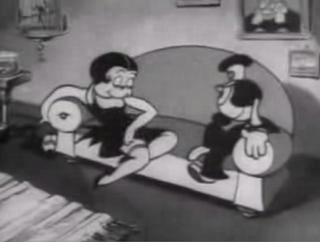




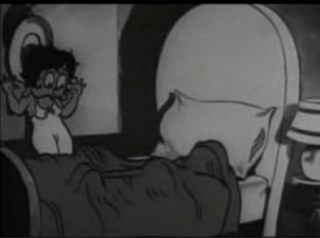




(Devon Aoki as Betty Boop)


(Betty was made into a Roy Lichtenstein looking comic thing on a coaster!)

Merchandise with Betty Boop's image on it is sold everywhere...but do people really know who she is or where she came from? I didn't!
Betty Boop as Snow White:
I love the theme song:
"Made of pen and ink,
She could win you with a wink,
Ain't she cute?
(boop- oop- e- doo)
Sweet Betty"
Thursday, November 16, 2006
For my project research on Betty Boop, I want to find out how many people really know who Betty boop is, what she symbolizes, where she came from, whether or not she was based on a real person or not, and what people associate her with.. I know she is a cartoon based on the 1920's flappers, and Ive read a basic history of Betty Boop...but I want to find out what other people know about her based on just hearing her name or seeing her image in stores. For part of my research, I want to go to stores that might feature her stuff and find out if the people selling Betty Boop stuff know what she is about. Also, I might ask random people questions about her in the form of a questionaire or survey, and possibly film it and put it into a mini documentary. I shall call it "The Elusive Betty Boop!" So far, I have asked a few people who they think she is, and from my friend Alex, all I got was "boop oop e do!" I think it might be interesting to piece together words and statements about who people think she is as well as finding out more about the history of her character- online, and possibly on film, if I can find any.

Wednesday, November 15, 2006
Betty Boop is an animated cartoon character appearing in the Talkartoon and Betty Boop series of films produced by Max Fleischer and released by Paramount Pictures. With her overt sexuality, Betty was a hit with theater-goers, and despite having been toned down in the mid-1930s, she remains popular today for this portrayal of sexuality.
Origins
Betty Boop was the first female flapper cartoon. She made her first appearance on August 9, 1930 in the cartoon Dizzy Dishes, the sixth installment in Fleischer's Talkartoon series. She was little like her soon-to-be-famous self, however. Grim Natwick, a veteran animator of both Walt Disney's and Ub Iwerks' studios, was largely responsible for creating the character, which he modeled on Helen Kane, a singer and contract player at Paramount Pictures, the studio that distributed Fleischer's cartoons. In keeping with common practice, Natwick made his new character an animal, in this case, a French poodle. Beginning with this cartoon, the character's voice was performed by several different voice actresses until Mae Questel got the role, in 1931, and kept it for the rest of the series.
Natwick himself later conceded that Betty's original look was quite ugly. The animator redesigned her in 1932 to be recognizably human in the cartoon Any Rags. Her floppy poodle ears became hoop earrings, and her poodle fur became a bob haircut. She appeared in ten cartoons as a supporting character, a flapper girl with more heart than brains. In individual cartoons she was called "Nancy Lee" and "Nan McGrew". She usually served as studio star Bimbo's girlfriend. She was not officially christened "Betty Boop" until the 1932 short Stopping the Show that same year. This was also the first cartoon to be officially part of the Betty Boop series and not a Talkartoon.
Although some claim that Betty's first name was established in the 1931 Screen Songs cartoon Betty Co-ed, this "Betty" was, in truth, an entirely different character. Though the song itself may have led to Betty's eventual christening, any references to Betty Co-ed as a Betty Boop vehicle have been made in error. (The official Betty Boop website describes the titular character as a "prototype" of Betty.) In all, there were at least 12 Screen Songs cartoons that featured either Betty Boop or a similar character.
[edit]Betty as sex symbol
Betty Boop in Betty Boop's Bamboo Isle (1932).
Betty's development was still incomplete, however. Max Fleischer's brother, Dave, further altered the character, making her sexier and more feminine. Betty's famous personality finally came into play in the 1932 short, Minnie the Moocher, to which Cab Calloway and his orchestra lent their talents. In the film, Betty runs away from her over-bearing parents only to get lost with costar Bimbo in a cave haunted by a walrus (rotoscoped from Calloway). The ghost's scary musical number impels Betty to flee back to the safety of home. The portrayal of Betty's parents as seemingly being Orthodox Jews has led many to assume that Betty herself was intended as an overtly Jewish character . However later episodes, such as the 1936 short 'Be Human,' introduced Betty's Grandpa, who was portrayed very much as an 'old timer' in the style of such characters from Wild West films.
Betty Boop is noteworthy for being the first cartoon character to fully represent a sexual woman. Other female characters of the same period showed their panties regularly, like Minnie Mouse, but didn't have a full caricature of a woman's form. Betty Boop, however, reveled in her sexuality. She wore short dresses and a garter belt. Her breasts were prominent, and she showed her cleavage. In her cartoons, other characters try to sneak peeks at her while she's changing. In Betty Boop's Bamboo Isle, she does the hula wearing only a lei and a grass skirt, a bit she repeated in her cameo appearance in the first Popeye cartoon.
Nevertheless, the animators made sure to keep the character "pure" and girl-like (officially, she was only 16 years old). As Betty tells Koko the Clown in the film Boop-Oop-A-Doop after being threatened by a salacious ringmaster, "He couldn't take my boop-oop-a-doop away!"
Her cartoons also stood out from the competition due to their upbeat jazz soundtracks. In addition to three cartoons with soundtracks by Cab Calloway, guest bands for Betty Boop cartoons included the bands of Louis Armstrong, Rudy Vallee, and Don Redman. Ethel Merman, Irene Bordoni and Reis and Dunn also appeared in a few shorts as guest performers.
The adult sensibilities of Betty's cartoons made her a hit, and a wave of merchandising soon swept the world. Meanwhile, Helen Kane, who had inspired the character in 1930, sued the Fleischer studio in 1934 for allegedly stealing her trademark look, dancing and singing style, and catchphrase. Kane lost the suit (and her boop-oop-a-doop) when the Fleischers proved that the phrase had been used by other performers before Kane.
The Hayes Code–safe Betty appears with comic strip character Henry in Betty Boop with Henry, the Funniest Living American (1935).
[edit]Betty tamed
In the end, Betty's heightened sexuality would spell her doom. The Production Code censorship laws enforced beginning in 1934 forced her to wear a longer skirt and less revealing neckline. Betty was no longer a flapper; she was a husbandless housewife with a little dog named Pudgy. The animators struggled to keep Betty's cartoons interesting by pairing her with popular comic strip characters, but none of these films were very successful (though one such pairing did propel Popeye into stardom of his own). Betty's cartoon career came to an end, at least temporarily, in 1939.
A Betty Boop comic strip by Max Fleischer was syndicated from 1934 through 1937. From 1984 through 1987, another strip, Betty Boop and Friends was produced by Brian Walker, Ned Walker, Greg Walker, and Morgan Walker.
[edit]Betty today
Betty Boop's films would reach audiences once again when they were placed into syndication on television in the 1950s by U.M.&M. T.V. Corp. and later National Telefilm Associates (NTA). U.M.&M. and NTA altered the Paramount openings, removing the Paramount logo from the opening and closing. However, the mountain part of the logo remains on television prints, usually with a U.M.&M. copyright, but some prints contain Paramount-Publix bylines.
She also gained exposure in the 1960s counterculture movement. NTA capitalized on this and bought the rights to her shorts to colorize and re-air them on TV as The Betty Boop Show. There was criticism towards NTA's colorization since, as Turner Entertainment later did with Fleischer's Popeye the Sailor, the Korean artists who traced the cartoons into coloe skipped drawings and simplified movements, using limited animation in place of Fleischer's full animation.
Ivy Films put together a movie of some of Betty's better shorts called The Betty Boop Scandals of 1974 which saw some limited success. NTA later released another compilation movie, Hurray for Betty Boop in 1980. Marketers rediscovered Betty Boop in the 1980s as well, and merchandise featuring the character (in her earlier, sexier form) is now widely available. Also in the 1980s, rapper Betty Boo (whose voice, image, and name were influenced by the cartoon character) rose to popularity in the UK.
In 1988, Betty appeared for the first time in years, with a cameo in the Academy Award-winning film Who Framed Roger Rabbit. It was widely reported that the animators had slipped in one frame of Betty nude, invisible to the audience, of course. If such a frame existed, it was replaced by a conventional frame once the movie came out on home video.
In 1993, animator Jerry Rees, best known for his film The Brave Little Toaster, wrote and produced a new Betty Boop feature film for Metro-Goldwyn-Mayer. Seventy-five percent of the film was storyboarded, but two weeks before voice recording was to begin, MGM switched studio chiefs and the project, tentatively called The Betty Boop Feature Script, was abandoned.
A display of Betty Boop collectables.
Ownership of the Boop cartoons has changed hands over the intervening decades due to a series of corporate mergers, acquisitions, and divestitures (mainly involving Republic Pictures and the 2006 corporate split of parent company Viacom into two separate companies). As of 2006, CBS Paramount Television handles television distribution, while, ironically, original distributor Paramount handles theatrical distribution, although any sort of rerelease has yet to be announced. Also, the Betty Boop character and trademark is currently owned by King Features Syndicate and Fleischer Studios.
The Betty Boop series continues to be a favorite of many critics, and the 1933 Betty Boop cartoon Snow White (not to be confused with Disney's 1937 film Snow White) was selected for preservation by the U.S. Library of Congress in the National Film Registry in 1994. Betty Boop's popularity persists as well, and references to the character appear in such wide-ranging places as the comic strip Doonesbury, where the character B.D.'s busty girlfriend/wife is named "Boopsie", and the animated reality TV spoof Drawn Together, where Betty is the inspiration for Toot Braunstein. A Betty Boop musical is due to be produced on Broadway, with music by Andrew Lippa. There are currently twenty-two public domain Betty Boop cartoons in the available at the Internet Archive.
Monday, November 13, 2006
New Idea!!
Well my topic has pretty much changed from "religious figures"- which isn't very contemporary, to "Jesus in American Politics." I found a fabulous cover of Newsweek, which depicts a cross wrapped in the American flag. It shows how very blatant the role of Christianity is in my nation's politics. So I decided to find out about certain issues and practices that are influenced by religion, and turn those depictions into pieces of clip art. I found photos online, photoshopped them with a filter- and I plan on tracing them with pen and then photocopying them, and coloring them. Here are some of them:
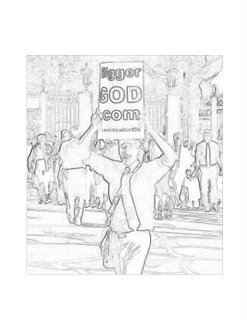







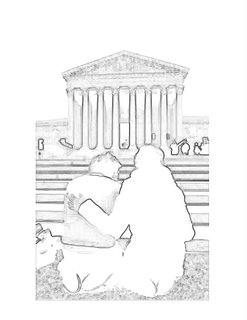
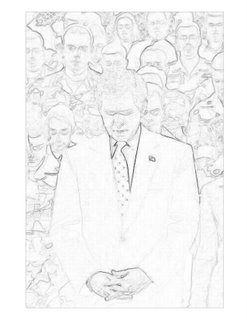
Much work to do.





